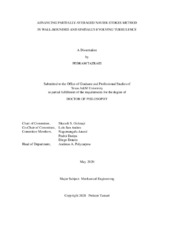| dc.contributor.advisor | Girimaji, Sharath S. | |
| dc.contributor.advisor | San Andres, Luis | |
| dc.creator | Tazraei, Pedram | |
| dc.date.accessioned | 2021-01-07T21:13:45Z | |
| dc.date.available | 2021-01-07T21:13:45Z | |
| dc.date.created | 2020-05 | |
| dc.date.issued | 2020-01-15 | |
| dc.date.submitted | May 2020 | |
| dc.identifier.uri | https://hdl.handle.net/1969.1/191887 | |
| dc.description.abstract | Scale-resolving simulations (SRS) of turbulence offer a computationally viable alternative to direct numerical simulations (DNS) and large eddy simulations (LES) for many flows of engineering interest. SRS seeks to achieve significant computational cost reduction over LES (large eddy simulations) by selective resolution of key coherent structures and modeling the remainder of the flow field using higher fidelity closures. SRS aims to provide significant improvements over Reynolds-averaged Navier-Stokes (RANS) method with only a reasonable increase in computational effort. The objective of this thesis is to advance bridging scale-resolving simulations to a state-of-the-art computational tool for the analysis, comprehension and prediction of turbulent flows of engineering interest. Toward this end, this thesis addresses key challenges facing SRS in near-wall subgrid closures, spatially-evolving flows and transition to turbulence. Scale-resolving simulations can be broadly classified into zonal (Z-SRS) and bridging (B-SRS) approaches. In Z-SRS different subgrid closure methods (e.g., RANS and LES) are used in different parts of the computational domain. One the other hand, B-SRS uses the same closure approach over the entire computational domain. The physical resolution (cut-off scale) of the subgrid model is controlled by changing the closure coefficients in a manner that is consistent with turbulence physics. The partially-averaged Navier-Stokes (PANS) method is a B-SRS approach that employs RANS-type two-equation (or better) closures that are suitably adapted to represent the required degree of spectral resolution. Three studies are undertaken in the thesis to advance PANS in wall-bounded flows with spatially-evolving turbulence and laminar-to-turbulence transition. Although all of the development is in the context of PANS, the findings of the thesis are generally applicable to other SRS methods. In the first study, equilibrium boundary layer (EBL) analysis is performed on the filtered turbulence to drive key closure models for scale resolving simulations (SRS) of turbulence. The objective is to convey the advantages of RANS near-wall closure modeling to SRS methodology. In the context of two-equation SRS turbulence closure, the EBL analysis of filtered-flow fields leads to closure models for turbulent transport of unresolved kinetic energy and dissipation as a function of degree of resolution. The resulting model is then employed to perform SRSPANS computations of a fully developed turbulent channel flow. It is demonstrated that PANS computations yield flow-field statistics that are consistent with filtered-field closure modeling assumptions. (This work has appeared in (1)). The second study aims to enhance the applicability and accuracy of SRS-PANS in fully-developed wall-bounded spatially-evolving turbulent flows. Scale resolving simulations of turbulence that employ two-equation subgrid closures require physically consistent boundary conditions for unresolved kinetic energy and dissipation (or frequency). Hence, the second work aims to develop accurate inflow turbulent boundary layer description by (i) adapting recycling/rescaling technique and (ii) extending equilibrium boundary layer scaling to partially resolved inflow fields. The proposed scheme is employed to compute a spatially-evolving zero pressure gradient flat plate boundary layer (ZPGFPBL) over a continuous range of Reynolds numbers based on the momentum thickness (650 ≤ Reθ ≤ 1434). The SRS results are then evaluated in the following categories: wall coefficients; mean-flow profiles; second-moment profiles; high-order statistics; and multi-point correlations. The third study is a preliminary investigation of adapting SRS in general, and PANS in particular, for simulating the laminar-turbulent natural K-type transition. The goal is to simulate key aspects of transition behavior in boundary layers at an affordable computational cost, which is significantly lower than that of LES. The development ensures that the appropriate physics, Tollmien-Schlichting (TS) waves and transport of momentum through the ejection and sweep mechanisms, are reasonably simulated in the near-wall region. The departure of the skin friction coefficient from the laminar curve, along with its overshoot in the post-transition regime are well-captured. The development of statistics into the fully-developed equilibrium state are confirmed. | en |
| dc.format.mimetype | application/pdf | |
| dc.language.iso | en | |
| dc.subject | natural transition over flat plate | en |
| dc.subject | turbulent boundary layer | en |
| dc.subject | channel flow | en |
| dc.subject | wall-bounded turbulent flows | en |
| dc.subject | partially-averaged Navier-Stokes method | en |
| dc.subject | OpenFOAM | en |
| dc.subject | scale-resolving simulations | en |
| dc.subject | coherent structures | en |
| dc.title | Advancing Partially-Averaged Navier-Stokes Method in Wall-Bounded and Spatially Evolving Turbulence | en |
| dc.type | Thesis | en |
| thesis.degree.department | Mechanical Engineering | en |
| thesis.degree.discipline | Mechanical Engineering | en |
| thesis.degree.grantor | Texas A&M University | en |
| thesis.degree.name | Doctor of Philosophy | en |
| thesis.degree.level | Doctoral | en |
| dc.contributor.committeeMember | Anand, Nagamangala | |
| dc.contributor.committeeMember | Daripa, Prabir | |
| dc.contributor.committeeMember | Donzis, Diego | |
| dc.type.material | text | en |
| dc.date.updated | 2021-01-07T21:13:45Z | |
| local.etdauthor.orcid | 0000-0002-9461-1704 | |


